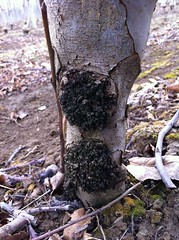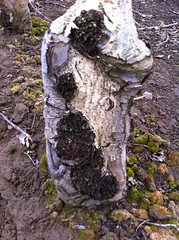Burr knots are root initials that appear on the aboveground portion of the apple tree trunk. Some rootstocks, such as M.7, M.9, M.26, MM.106, and MM.111, are more prone to developing burr knots than others. Conditions that favor burr knot development include low light, high humidity, and temperatures between 68°F and 95°F.
Burr knots are problematic in a couple of ways. They can be an entry point for organisms, such as dogwood and plum borers, woolly apple aphids, fire blight bacteria, and wood-rotting fungi. A tree with a heavy fruit load and many burr knots may produce weak growth or break during windy conditions.
Selection of a rootstock that does not produce burr knots is the best method of control. Painting Gallex® on burr knots aids in callus formation, or healing of the tissue; however, Gallex® may be difficult to obtain for small plantings of trees. Tree guards or tubes that encircle the trunk are not recommended as they provide shelter for insects and enhance environmental conditions favoring burr knot development. If soil is mounded to cover burr knots on the trunk, the dwarfing effect on the tree will be lost.
| An example of burr knots on an apple tree. Photo: Emily Hoover, University of Minnesota. | An example of burr knots on an apple tree. Photo: Emily Hoover, University of Minnesota. |
|---|---|
 |
 |
